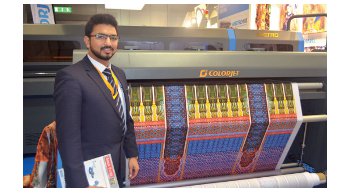
ColorJet: The digital printing expert
?ColorJet has five ranges of digital textile printers. These are Vastrajet, Fabjet, Metro, Fabjet Duo and Aurajet Dye sublimation printers
?ColorJet has five ranges of digital textile printers. These are Vastrajet, Fabjet, Metro, Fabjet Duo and Aurajet Dye sublimation printers. Each of these printers address specific needs of various printers, while offering economies of scale,? said Smarth Bansal, Brand Manager at Colorjet Group. ?At ColorJet, we have seen good demand from both domestic and international market and have installed our direct to fabric printers in India as well as many other countries. Till date, ColorJet has installed and implemented over 4,000 of its printing solutions and products across 315 cities around the world,? he added.
ColorJet Group is one of the largest manufacturers of digital inkjet printers in India, and markets its products in 14 countries worldwide. Founded in 2004, the company maintains its operations via two manufacturing facilities and sales offices spread across seven countries, which include India, China, Bangladesh, UAE and Sri Lanka.
After receiving good reviews and orders at ITMA 2015, ColorJet Group, one of the largest manufacturers of digital printing machines in India, has now introduced the METRO recently at GARFAB 2016. The METRO is a truly advanced high speed industrial grade digital textile printer, which fantastically incorporates the latest technology and efficient engineering to meet ever growing demands. It operates at a maximum speed of 362 sq m per hour.
The high speed is achieved through specially-designed jetting controls to optimise print heads performance, to match the high jetting frequency and the mechanical structure is designed to handle high speeds and precise dot placements. Compatible to work with all types of inks like reactive acid disperse and pigment, this printer weaves magic on a variety of fabrics. Be it any kind of fabric, ranging from 0.1 mm to 30 mm including cotton, polyester, silk, viscose, wool, nylon, acetate and various blended fabrics can be printed on the METRO. With awesome scalable properties, this printer can suit all the needs of the textile printing business and delivers in the least payback period. It is equipped with a heater and feeder is capable of meeting the ever changing requirements of the fabric printing industry.
In an exclusive interaction with the ITJ?s Sr Sub Editor Karthik Muthuveeran, Smarth Bansal, Brand Manager at Colorjet Group shares about the market for digital printing in India and its future.
What do you think are the big benefits of your company?s specific technology and machinery?
Smarth Bansal: The main benefit from our company is the efficient engineering that we bring into every machine we manufacture and since it?s a made in India product, we make sure that the machines are produced keeping in mind the requirements of the Indian fabrics printing market.
We have digital textile printers to print whether natural fibre or man-made fibre fabrics and also low volume or high volume printing.
Where are your markets located– globally? What are your future strategies?
Smarth Bansal: Apart from India, ColorJet has its distribution network in Sri Lanka, Egypt, Kenya, Dubai, Bahrain and many other countries. Our future target markets are Indonesia, Philippines, Turkey and Vietnam.
How important is India?s market in your scheme of things? How are you developing it?
Smarth Bansal: Since we are an Indian company, the market is obviously and really important considering that the country is the second biggest global producer of textiles. We are developing our market by learning the requirements of the Indian market and then developing printers which meets those requirements. Towards that end, we are launching a new digital industrial textile printer, the Metro at Garfab trade show.
What changes and developments do you foresee in digital printing for the future?
Smarth Bansal: Earlier, fabrics needed to be pre-treated before digital printing, but we now offer technology, which eliminates the need to do so, ensuring faster turnaround times. Secondly, we see pigment ink printing gaining more acceptance, due to the versatility it brings with it. As and when costs go down, digital printing is expected to be the next driver of growth for the textile industry.
For more information, visit www.colorjetgroup.com



